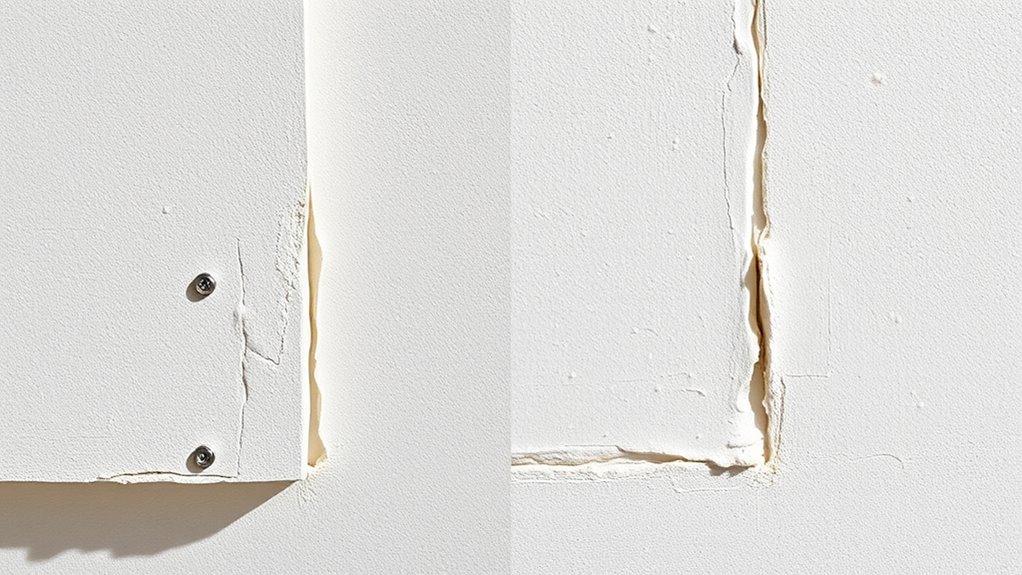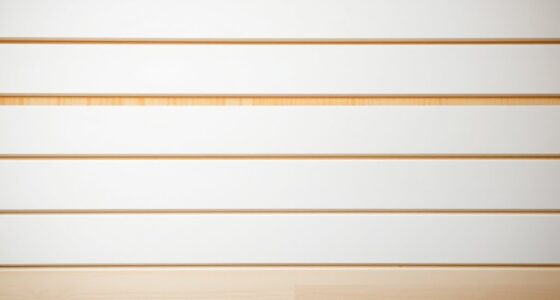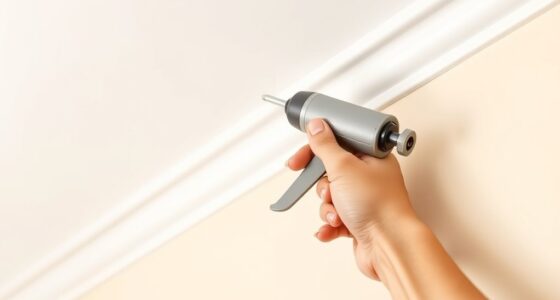When upgrading drywall joints, choosing between butt and tapered joints impacts both finish quality and durability. Tapered joints are easier to finish with smoother, more professional results because they allow better tape embedding and feathering. Butt joints require more effort, needing extra coats and careful sanding to look seamless. If you want a long-lasting, clean finish, tapered joints are usually better. Explore further to discover tips on making this progression smoother and more effective.
Key Takeaways
- Tapered joints are easier to finish smoothly and produce a professional appearance, ideal for new drywall installations.
- Butt joints require extra finishing effort and multiple coats to achieve a seamless surface.
- Tapered joints provide better bonding and durability, reducing long-term cracking and damage risks.
- Butt joints are commonly used for repairs or tight spaces where tapering isn’t feasible.
- Upgrading involves choosing tapered joints for a clean, long-lasting finish or using butt joints for quick fixes.

When choosing the right drywall joint for your project, understanding the differences between butt joints and tapered joints is essential. Your decision impacts not only the structural integrity but also the overall appearance of the finished wall. Butt joints are created when drywall sheets meet edge to edge without any special shaping, resulting in a flat seam. These joints are common in repairs or situations where drywall sheets are cut to fit tight spaces. However, they can be more challenging to finish smoothly because the seam lacks the natural taper that helps hide joint compound. When tackling joint repair, you’ll need to pay extra attention to finishing techniques to prevent cracks or visible seams down the line.
Choosing between butt and tapered drywall joints affects both strength and finish quality of your wall.
Tapered joints, on the other hand, are formed by scoring or cutting the drywall edges to create a slight bevel. This bevel allows for a smoother finish because the joint compound can be applied more evenly and feathered out over the tapered edge. If you’re working on a new wall or installing drywall from scratch, tapered joints are typically the preferred choice since they make finishing easier and produce a cleaner look. The taper provides a natural slope that makes it easier to hide joint tape and compound, reducing the amount of finishing work needed to achieve a seamless surface.
When it comes to finishing techniques, tapered joints provide a significant advantage. The tapered edge allows you to embed joint tape securely and apply a thin, even layer of compound that can be feathered out on both sides of the seam. This results in a flatter, smoother surface, minimizing the risk of visible ridges or bumps. Butt joints require more meticulous finishing techniques because the flat edge demands multiple coats of compound and careful sanding to blend seamlessly with the drywall surface. You might find yourself doing additional joint repair work to fix any imperfections or avoid cracking over time.
Choosing between these two joint types also affects the durability of the finished wall. Tapered joints tend to hold up better over time because the taper provides extra surface area for the joint compound to bond, reducing the chances of cracks. Butt joints, while sometimes necessary for specific situations, often need extra reinforcement, like corner beads or additional taping, to ensure a long-lasting finish. Efficient finishing techniques are key regardless of which joint type you select, but tapered joints generally make the process easier and yield more professional results with less effort.
Frequently Asked Questions
Can Tapered Joints Be Used for Curved Drywall Installations?
Yes, tapered joints can be used for curved drywall installations because they offer better joint flexibility. This flexibility allows the drywall to bend and follow curves more smoothly, resulting in a cleaner, professional look. You should consider tapered joints when working on curved installations, as they help minimize cracks and make finishing easier. By choosing tapered joints, you guarantee your drywall seamlessly conforms to the curve, enhancing the overall appearance of your project.
Which Drywall Joint Type Offers Better Soundproofing?
Imagine a quiet sanctuary—your home. Tapered joints often offer better soundproofing benefits because they create smoother, more seamless drywall surfaces that enhance acoustic performance. By reducing gaps and cracks, tapered joints minimize sound transmission, giving you peace and privacy. If soundproofing matters to you, choosing tapered joints can profoundly improve your space’s acoustic quality, making every moment at home more serene and comfortable.
Are There Cost Differences Between Butt and Tapered Joints?
You’ll find that tapered joints generally cost a bit more than butt joints because they require more precise cuts and additional taping, which increases installation expenses. The cost comparison shows that tapered joints may lead to higher labor and material costs, but they often offer a smoother finish. If budget is a concern, butt joints could be a more economical choice, though they might need extra finishing work later.
How Do Environmental Factors Affect Joint Choice?
Did you know that 60% of drywall failures are linked to environmental factors? When choosing joints, consider moisture resistance and environmental durability. Tapered joints are better for environments with fluctuating humidity because they create a stronger bond and smoother finish. Butt joints may not withstand moisture as well, making tapered joints the smarter choice for areas prone to humidity or water exposure, ensuring your wall lasts longer.
Is Special Drywall Tape Required for Butt Joints?
You don’t need special drywall tape for butt joints, but using the right tape improves joint strength and tape compatibility. Regular fiberglass mesh tape works well, but for added durability, especially in high-stress areas, consider paper tape designed for butt joints. This tape helps create a smoother finish and better bond, reducing cracking over time. Always guarantee your tape is compatible with your joint compound for ideal results.
Conclusion
Choosing between butt and tapered drywall joints is like selecting the right brush for a painting project—you want the one that fits best. Tapered joints are easier to finish smoothly, like a well-run brushstroke, while butt joints require more effort but can be just as durable. Consider your skill level and project needs. With the right choice, you’ll create a seamless wall that feels as smooth as glass, making your space look polished and professional.









